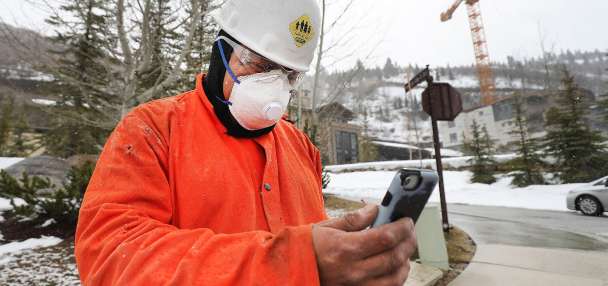Estimated read time: 6-7 minutes
This archived news story is available only for your personal, non-commercial use. Information in the story may be outdated or superseded by additional information. Reading or replaying the story in its archived form does not constitute a republication of the story.
SALT LAKE CITY — Masks to stop the spread of COVID-19 will still be required statewide for at least the next month under a new public health order that went into effect Tuesday; however, the state health department offered new insight as to when that requirement will be lifted in areas of "low transmission."
The order, issued by Utah Department of Health executive director Rich Saunders, also puts in place increased testing that will be required for one-time extracurricular high school activities and a "test to stay" policy for a K-12 school to remain open after an outbreak. It also eases some restrictions for bars and public gatherings in areas with "moderate" transmission.
Saunders signed the new statewide health order Monday evening. It replaces the previous order, which went into effect Jan. 21, and expired Monday night. The new public health order will remain in effect through March 25.
An update to mask requirements
Masks are still required throughout Utah regardless of transmission levels under the new public health order. That means face coverings are required in indoor public settings and public outdoor settings in situations within 6 feet of an individual from a different household. Businesses and event hosts are still required to comply with "any face mask or physical distancing requirements required" under the update.
This requirement is certain to be extended beyond March 25; however, the state health department on Tuesday also revealed the first benchmark that will begin to remove the requirement.
The public health order states counties with "low transmission" levels will be able to remove the requirement eight weeks after the department has been allocated 1.63 million first doses of the COVID-19 vaccine.
It's currently unclear exactly when that timeline will begin. So far, nearly 445,000 doses have been allocated for Utah and over 410,000 Utahns have received their first dose of the vaccine, according to the Utah Department of Health.
If Utah had reached 1.63 million allocated doses Tuesday, then the order would be lifted in any "low transmission" counties on April 20. That means the requirement will likely only begin to be lifted in some areas sometime in late spring or early summer this year based on the definition offered Tuesday.
In a tweet Tuesday afternoon, Gov. Spencer Cox wrote that "soaring" vaccine distribution in the coming weeks is why he believes that many areas of the state might be able to celebrate July 4th without the mask mandate in place.
"I truly believe that we will be celebrating maskless in large groups by the 4th (if not sooner)," he tweeted.
I'm really baffled by the pessimism we keep hearing from DC. Almost all the science (including concerns about variants) is overwhelmingly positive. With vaccine numbers soaring, I truly believe that we will be celebrating maskless in large groups by the 4th (if not sooner). https://t.co/aOYDqRudjV
— Spencer Cox (@SpencerJCox) February 23, 2021
Of course, that still depends on if Utah does indeed receive the number of vaccines it expects in the coming weeks and months, and if other factors, such as case rates and intensive care unit utilization. If those rates continue trending downward and vaccines arrive on time as expected, then it certainly could be possible for many counties
Other notable changes
Meanwhile, the order requires a "test to play" for "a one-time school-sponsored extracurricular" at high schools. These are defined as events like social dances and comes into play ahead of the typical prom season.
It also requires "test to stay" measures for school districts following an outbreak at a school.
"If the school implements 'Test to Stay,' any student who tests positive must transition to remote learning for 10 days from the date of their test," the health department stated. "Students who choose not to be tested should also transition to remote learning for 10 days if less than 60% of the school population participated in the testing event or if the percent positivity from the testing event is 2.5% or higher."
Health department officials said the reason behind this amendment is that there's an avenue for in-person learning to continue even if a school reached the "outbreak threshold" level.
The other big changes are at bars or any public gatherings in counties of "moderate" level of transmission. The order states any bar in areas of "moderate" transmission no longer have to limit capacity to 75% but masks are still required and groups must remain at least 6 feet apart from each other.
Live events — from weddings to theaters to sporting events — in those areas may include "side-by-side" seating if "all patrons are wearing masks and can attest to being free of COVID-19 symptoms, and are not subject to quarantine or isolation," the health department added.
Masks are still required except when someone is eating or drinking. Six feet distance is also required during times of eating and drinking. If someone tests positive after the event, hosts are also still required to contact attendees who may have been in close contact with that person.
A change to transmission rate thresholds
Speaking of the county transmission levels, the final noticeable change involves the transmission level thresholds. The state added a "test over test" positivity rate model to its data this month. The model creates a positivity rate based on the number of positive cases found over the total number of tests conducted.
"This test over test method is going to allow us to see the benefit of our increased testing capacity. We want people to get tested, and testing is a key intervention to slowing the spread of COVID, said Dr. Angela Dunn, the state's epidemiologist, during a briefing with reporters earlier this month.
The new health order accommodates that change. It's one of three categories to lead to a county moving for "low" or "moderate." The other two are having a low enough 14-day case rate per 100,000 people or intensive care unit utilization rates. A county must have at least two of those targets to move up.
In regard to the positivity rate, "moderate" is a county with a positivity rate between 5.1% and 9.9%, while "low" is anything below 5%. "High" is classified as anything 10% or higher.
Per health department data, most counties would meet the baseline of the two lower categories for positivity rate. Through Feb. 16, the data show only Beaver, Grand, Kane, Sanpete and Sevier had "test over test" positivity rates above 10%. A county would still need to have low enough case rates per capita or low enough ICU utilizations to move into "moderate" or "low" status.
As of Tuesday, 13 counties in the state are listed as "moderate" or "low" transmission remain Box Elder, Carbon, Daggett, Duchesne, Garfield, Millard, Morgan, Piute, Rich, San Juan, Uintah, Wayne and Weber counties.










